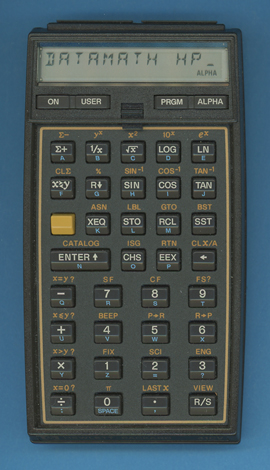
DATAMATH CALCULATOR MUSEUM
 |
DATAMATH CALCULATOR MUSEUM |
Hewlett-Packard HP-41C, CV
| Date of introduction: | 1979 | Display technology: | LCD 14-segment |
| New price: | $325.00 $175.00 (SRP 1988) |
Display size: | 10 + 2 |
| Size: | 5.6" x 3.1" x 1.2" | ||
| Weight: | 5.5 ounces | Serial No: | 2321S40332 |
| Batteries: | 4*N cells | Date of manufacture: | wk 21 year 1983 |
| AC-Adapter: | Origin of manufacture: | Singapoore | |
| Precision: | 10 | Integrated circuits: | |
| Memories: | 63-0 | ||
| Program steps: | 441 | Courtesy of: | Peter Muckermann |
 The
HP-41C could be called a small revolution in the pocket. Following the path of
programmable calculators like the HP-67 or TI-59
it overcame their limitations of the stupid men-machine interface possible with
a numerical keypad and a 7-segment display. The HP-41C added alphanumeric
capabilities to both the display and keyboard using 14-segments and an
ALPHA-key. In addition the memory capacity was enhanced and uses non-volatile
integrated circuits (RAM) like the TI-58C.
A total of 4 slots allowed further expansion of either RAM capacity,
pre-programmed ROM-modules or peripheral devices like a card reader or printer
modules.
The
HP-41C could be called a small revolution in the pocket. Following the path of
programmable calculators like the HP-67 or TI-59
it overcame their limitations of the stupid men-machine interface possible with
a numerical keypad and a 7-segment display. The HP-41C added alphanumeric
capabilities to both the display and keyboard using 14-segments and an
ALPHA-key. In addition the memory capacity was enhanced and uses non-volatile
integrated circuits (RAM) like the TI-58C.
A total of 4 slots allowed further expansion of either RAM capacity,
pre-programmed ROM-modules or peripheral devices like a card reader or printer
modules.
Texas
Instruments developed with the TI-88 a
similar calculator – unfortunately it never appeared in the market place. It
took some time before Texas Instruments took the leadership again with the first
Graphics calculator TI-81 in
1990.
The pictured HP-41CV integrated 4 memory modules featuring 319 registers instead the 63 of the original HP-41C but is otherwise identical. The HP-41CX added the Time module and some additional functions to the HP-41CV.
| An example of a memory module. |  |
| The optional card reader. |  |
| A HP-41CV wth additional card reader and installed memory modules. |
![]()
If you have additions to the above article please email: joerg@datamath.org.
© Joerg Woerner, May 3, 2002. No reprints without written permission.